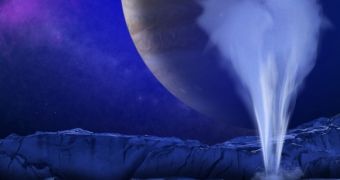A series of recent observations conducted with the NASA/ESA Hubble Space Telescope have revealed the presence of water vapors at the south pole of Europa, one of the moons around Jupiter.
This study is the first to provide accurate, concrete evidence for the long-theorized water plumes believed to be released from this particular location. Scientists hypothesized that the polar regions on Europa would display a behavior similar to that seen on another icy moon, Saturn's Enceladus.
These two moons, alongside Titan – also around Saturn – are the most promising candidates for finding life at other locations in the solar system. While Europa and Enceladus feature icy surfaces that may cover up oceans of liquid water, Titan features an atmospheric cycle similar to Earth's, except that it is based on hydrocarbons such as methane and ethane instead of water.
According to researchers with the Southwest Research Institute (SwRI), in San Antonio, Texas, it would appear that the most likely explanations for the water plumes Hubble saw is a liquid ocean located under the moon's kilometers-thick icy crust. However, other explanations may still be possible.
Details of the new study were presented on Thursday at the annual meeting of the American Geophysical Union, held in San Francisco, California, and supported by a paper published in the December 12 online issue of the top journal Science Express.
“By far the simplest explanation for this water vapor is that it erupted from plumes on the surface of Europa,” says SwRi investigator Lorenz Roth, who was also the lead author of the new paper.
“If those plumes are connected with the subsurface water ocean we are confident exists under Europa's crust, then this means that future investigations can directly investigate the chemical makeup of Europa's potentially habitable environment without drilling through layers of ice,” he explains.
The research teams believes that Europa surface features called lineae – similar to Enceladus' tiger stripes – may be responsible for releasing the tenuous water plumes. For these observations, Hubble's capabilities were pushed to their limits.
“If confirmed, this new observation once again shows the power of the Hubble Space Telescope to explore and opens a new chapter in our search for potentially habitable environments in our solar system” says John Grunsfeld, the associate administrator for science at NASA Headquarters, in Washington.
“The effort and risk we took to upgrade and repair Hubble becomes all the more worthwhile when we learn about exciting discoveries like this one from Europa,” adds the official, a former astronaut who took part in a couple of the shuttle missions NASA used to maintain telescope over its 22 years of service.

 14 DAY TRIAL //
14 DAY TRIAL //